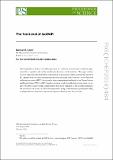The front-end of IsoDAR
Author(s)
Axani, Spencer Nicholas; Winklehner, Daniel; Conrad, Janet Marie
DownloadICHEP2016_484.pdf (1.501Mb)
PUBLISHER_CC
Publisher with Creative Commons License
Creative Commons Attribution
Terms of use
Metadata
Show full item recordAbstract
The Isotope Decay-At-Rest (IsoDAR) experiment is a cyclotron based neutrino oscillation exper- iment that is capable of decisively searching for low-mass sterile neutrinos. This paper outlines two new approaches that the IsoDAR collaboration are pursuing in order to increase the amount of H + 2 captured in the cyclotron through innovations in the design of the front-end. A new dedicated multicusp ion source (MIST-1) is currently being commissioned and tested at the Plasma Science and Fusion Center (PSFC) at MIT. Based on previous results from this type of ion source, we ex- pect to be able to achieve an H+₂ current density that will be sufficient for the IsoDAR experiment. We also discuss the results of a new investigation into using a radio frequency quadrupole (RFQ) as a high-efficiency buncher to improve the injection efficiency into the cyclotron.
Date issued
2017-02Department
Massachusetts Institute of Technology. Department of Physics; Massachusetts Institute of Technology. Laboratory for Nuclear ScienceJournal
Proceedings of 38th International Conference on High Energy Physics — PoS(ICHEP2016)
Publisher
Sissa Medialab
Citation
Axani, Spencer, Daniel Winklehner, and Janet Conrad. “The Front-End of IsoDAR.” Proceedings of 38th International Conference on High Energy Physics — PoS(ICHEP2016) (February 6, 2017).
Version: Final published version